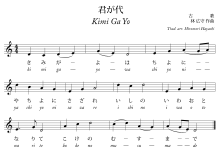Kimi Ga Yo facts for kids
| English: His Imperial Majesty's Reign | |
|---|---|
| "Kimigayo" | |

Score of "Kimigayo"
|
|
| National anthem of | |
Kimigayo is the national anthem of Japan. Its name means "His Imperial Majesty's Reign." The words of this song are the oldest among all national anthems in the world. It is also one of the shortest national anthems.
The lyrics come from a poem written by someone unknown during the Heian period (794–1185). The music we hear today was chosen in 1880. It replaced an older tune that people did not like as much.
In 1999, Japan passed a law called the "Act on National Flag and Anthem." This law officially made both the Hinomaru (Japan's flag) and "Kimigayo" the national symbols of Japan.
Contents
A Song Through History
During World War II, the Japanese Empire asked schoolchildren to sing "Kimigayo." They also had to salute Emperor Hirohito every morning. This was a way to show loyalty to their country and leader.
What Do the Lyrics Mean?
The words of "Kimigayo" are very old. They come from a short Japanese poem. The poem wishes for a long and peaceful reign for the Emperor. It talks about tiny pebbles that grow into giant rocks covered with moss. This is a way to say "for a very, very long time."
The Music of Kimigayo
The current melody for "Kimigayo" was chosen in 1880. It was composed by Franz Eckert, a German musician. Before this, there was another melody composed in 1869. However, people did not find that first tune very appealing, so a new one was created.
Becoming Official
For many years, "Kimigayo" was used as Japan's national anthem. But it was not officially recognized by law until 1999. The "Act on National Flag and Anthem" finally made it the official national anthem. This law also made the Hinomaru flag the official national flag.
Images for kids
-
Sazare-Ishi pebbles are believed to grow into boulders in some legends. A photo taken at Shimogamo Shrine in Kyōto.
-
A photo taken on November 6, 2007, as "Kimigayo" was being played before a volleyball tournament in Ōsaka
See also
 In Spanish: Kimigayo para niños
In Spanish: Kimigayo para niños






